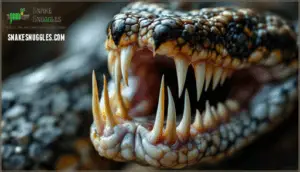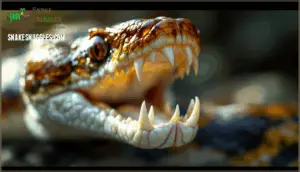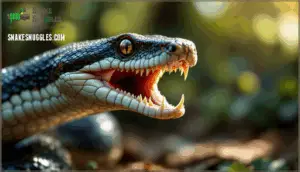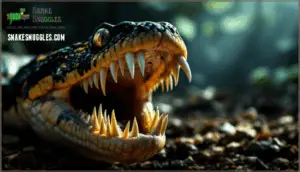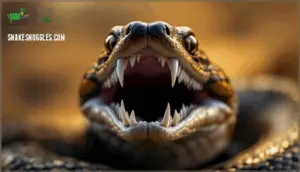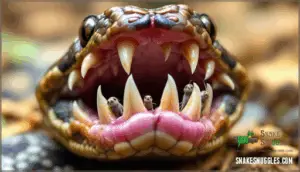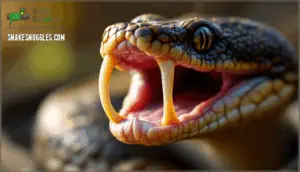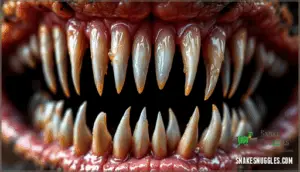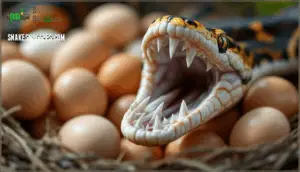This site is supported by our readers. We may earn a commission, at no cost to you, if you purchase through links.
 Most people picture snake fangs dripping venom, but the truth is far more varied. Snakes possess an impressive range of tooth types, each shaped by millions of years of evolution to match specific hunting styles and diets.
Most people picture snake fangs dripping venom, but the truth is far more varied. Snakes possess an impressive range of tooth types, each shaped by millions of years of evolution to match specific hunting styles and diets.
Some snakes grip prey with simple curved teeth, while others inject venom through hollow fangs or grooved channels. Understanding these dental differences reveals how snakes conquered nearly every habitat on Earth, from deserts to oceans.
Whether you’re curious about safety or simply fascinated by these reptiles, knowing how snake teeth work helps you appreciate the striking adaptations that make them such successful predators.
Table Of Contents
- Key Takeaways
- What Are Snake Teeth Called?
- What’s So Special About Snake Teeth?
- Do All Snakes Have Teeth?
- Can Snakes Unhinge Their Jaws?
- Do Snakes Have Teeth Like Humans?
- How Many Teeth Do Snakes Have?
- What Kind of Teeth Do Snakes Have?
- Do Snakes Lose Their Teeth?
- Do Snakes Have Teeth That Are Hollow?
- Different Rows of Teeth
- Some Snake Species Don’t Possess Teeth
- Frequently Asked Questions (FAQs)
- How many teeth does a snake have?
- Why do snakes have sharp teeth?
- Do venomous snakes have teeth?
- What are the different types of snake teeth?
- Can a snake eat without teeth?
- Do snakes have aglyphous teeth?
- What Types of Teeth Do Snakes Have?
- Do Different Snake Species Have Different Types of Teeth?
- How Do Snake Teeth Evolve Over Time?
- How Do Snake Teeth Help Snakes Hunt and Eat?
- Conclusion
Key Takeaways
- Snakes possess four distinct tooth types—aglyphous (simple curved teeth), solenoglyphous (hollow retractable fangs), proteroglyphous (fixed front fangs), and opisthoglyphous (grooved rear fangs)—each designed for specific hunting strategies ranging from constriction to venom injection.
- All snake species have teeth, though the number varies dramatically from 10 to over 200 depending on diet and hunting style, with pythons and boas carrying more teeth than smaller species.
- Snakes are polyphyodonts, meaning they continuously replace teeth throughout their lives as teeth break during feeding, ensuring they always maintain functional gripping or venom-delivery systems.
- Snake teeth curve backward to prevent prey escape and work with independently moving jaw bones (not "unhinging") to swallow whole prey much larger than their head size.
What Are Snake Teeth Called?
Ever wonder why scientists don’t just call them ‘snake teeth’ and leave it at that? The reason comes down to function. Snake teeth types reveal how each species hunts and survives.
Scientists classify snake teeth structure into four main categories based on tooth morphology and venom delivery systems: aglyphous, solenoglyphous, proteroglyphous, and opisthoglyphous. These dental nomenclature terms describe fang types that evolved over millions of years. Each design fulfills a purpose, from gripping prey to injecting toxins.
Understanding tooth evolution helps you recognize which snakes pose risks and how their teeth adapted to different hunting strategies.
What’s So Special About Snake Teeth?
Snake teeth aren’t just your everyday chompers. These specialized structures come in four distinct types, each designed for a specific hunting strategy.
Let’s look at how each type works and what makes it unique.
Aglyphous Teeth
Aglyphous teeth represent the most primitive dentition in snake anatomy. You’ll find these simple, non-specialized teeth in nonvenomous snakes like pythons and boa constrictors. Unlike fanged species, aglyphous teeth are solid, cone-shaped structures that curve backward—perfect for gripping prey during constriction.
Here’s what makes this tooth morphology effective:
- All teeth are roughly the same size and shape throughout the mouth
- The backward curve prevents prey from escaping once caught
- Non-venomous snakes rely entirely on these teeth for securing food
- Tooth placement varies by family, optimizing grip during whole-prey swallowing
This basic dental structure works beautifully for snakes that overpower prey through constriction rather than venom injection. Snakes accomplish this feat using a unique method of internal tooth resorption.
Solenoglyphous Teeth
Vipers and a few other sophisticated venomous snakes pack the most lethal dental hardware in the reptile world. Solenoglyphous teeth are hollow fangs that work like hypodermic needles—they inject venom deep into prey with precision. What makes viper fangs remarkable is their rotating mechanism. These fangs fold flat against the roof of the mouth when not needed, then swing forward up to 90 degrees during a strike.
Viper fangs are hollow, rotating needles that fold flat when idle and swing forward 90 degrees to inject venom with surgical precision
The mechanics behind this fang rotation allow vipers to deliver high-pressure venom injection in milliseconds. Some species, like the Gaboon viper, have fangs exceeding 5 centimeters (2 inches)—the longest among all snake species.
| Feature | Description |
|---|---|
| Structure | Hollow channel runs through entire fang |
| Rotation | Fangs fold back when mouth closes |
| Length | Can exceed 5 cm in some viper species |
| Function | Delivers venom under high pressure |
| Advantage | Lets them strike-and-release hunting strategy |
You’ll find this fang type exclusively in vipers and pit vipers—true specialists in venom delivery systems.
Proteroglyphous Teeth
While vipers rely on rotating fangs, elapids like cobras and mambas take a different approach. Proteroglyphous teeth are fixed fangs positioned at the front of the mouth—they can’t fold back or extend. These short, hollow fangs deliver venom quickly during a bite, making them highly effective for neurotoxin injection.
Elapid snake fangs stay locked in place, which means cobra dentition differs markedly from viper anatomy. This fixed fang design suits their hunting style perfectly:
- Short length allows faster strikes without mechanical delay
- Hollow channels guide venom directly into prey tissue
- Fixed position means immediate venom delivery on contact
- Front placement maximizes efficiency during defensive or predatory bites
You’ll recognize proteroglyphous snake teeth in species like king cobras, black mambas, and coral snakes—all masters of rapid venom delivery through permanently positioned fangs.
Opisthoglyphous Teeth
Not all venomous snakes strike from the front. Opisthoglyphous teeth are enlarged, grooved fangs positioned at the back of the upper jaw—think of them as the surprise weapon of rear-fanged colubrids. These snakes must chew or hold prey longer to work venom into the wound, making prey incapacitation slower than front-fanged species.
- Grooved channels guide venom along the tooth surface during prolonged bites
- Rear placement requires deeper jaw engagement for effective venom delivery
- Colubrid dentition varies widely, with some species posing minimal threat to humans
- Rear-fanged evolution demonstrates how snake dentition changes to different hunting strategies
Boomslangs and twig snakes showcase this fang type perfectly—dangerous but requiring sustained contact to deliver significant venom.
Do All Snakes Have Teeth?
Every snake species has teeth, though the type and number differ based on their diet and hunting style. You’ll find venomous vipers equipped with large retractable fangs, while cobras and mambas use fixed front fangs to deliver potent toxins. Some snakes, like hognose species, have rear-fanged teeth for injecting milder venom into prey.
Even nonvenomous snake species like boas and pythons possess rows of sharp, backward-curving teeth for gripping their meals. While blind snakes have reduced dentition, they still retain small teeth. The idea of truly toothless snake species is largely a myth—evolutionary tooth loss hasn’t eliminated teeth entirely from any snake family, though some have dramatically reduced them. The development of these fangs is linked to the evolution of plicidentine.
Egg-eating snakes present an interesting case: they lack conventional teeth but have developed bony projections in their throat to crack open eggs efficiently.
Can Snakes Unhinge Their Jaws?
You’ve probably heard the myth that snakes can pop their jaws completely out of place to swallow massive prey—but does that really happen? The truth is, snakes don’t unhinge their jaws at all. Instead, their skull structure features highly flexible ligaments connecting the lower jaw bones, allowing each side to move independently.
This jaw flexibility gives them an evolutionary advantage when tackling prey size that seems impossible. The jaw muscles stretch considerably, and the unique snake jaw structure lets them work one side forward, then the other, gradually "walking" their mouth over food. It’s not jaw unhinging—just striking adaptation.
Do Snakes Have Teeth Like Humans?
If you opened a snake’s mouth and compared it to your own, you’d notice right away that their teeth look nothing like yours. While you have flat molars for grinding and rooted teeth anchored in sockets, snakes possess rows of needle-sharp, backward-curving teeth that lack tooth enamel and grow directly from the jawbone. Your teeth are built for chewing function, but snake teeth serve a completely different purpose—they’re designed to grip and hold prey, not break it down.
Snake dentition reflects their unique jaw structure and feeding strategy. Instead of your permanent set of teeth, snakes are polyphyodonts, continuously replacing teeth throughout their lives. The tooth shape in snakes is conical and pointed, perfectly adapted for catching prey that might otherwise escape. Some species have up to 200 teeth—that’s more than six times what you’ve got. Snake anatomy and teeth work together with those flexible jaw ligaments you learned about earlier, creating an efficient system for swallowing prey whole.
How Many Teeth Do Snakes Have?
Snake dentition varies dramatically across species, with most possessing anywhere from 80 to well over 200 teeth. Your typical boa constrictor carries more than 100 teeth, while a king cobra usually has fewer than 100. The exact count depends on what they eat and how they hunt—it’s all about matching tooth number variation to their lifestyle.
Here’s what shapes how many teeth a snake has:
- Diet drives design: Snakes eating hard-shelled prey develop stout, sturdy teeth, while those catching slippery fish sport long, curved needle-sharp grippers that won’t let go.
- Specialized feeders break the rules: Egg-eating snakes have drastically fewer teeth overall, relying instead on a blade-like structure at the jaw’s rear for cracking shells.
- Asymmetrical dentition exists: Some snail-eating species pack more teeth on their right side—a quirky adaptation for extracting prey from spiral shells.
- Jaw structure matters: With unfused mandibles and multiple tooth rows (two lower, up to four upper), snake teeth arrangement maximizes grip without blocking their amazing swallowing ability.
What Kind of Teeth Do Snakes Have?
Snakes don’t chew their food, so their teeth serve a completely different purpose than yours—they’re built to grip, hold, and sometimes inject venom into prey. The basic design features curved, backward-pointing teeth that hook into prey like tiny anchors, preventing escape. Beyond these standard grippers, fang morphology divides into four distinct categories based on venom delivery systems and dental adaptations shaped by evolutionary origins.
| Fang Type | Structure | Snake Examples |
|---|---|---|
| Aglyphous | Solid, curved teeth with no venom groove | Pythons, boas |
| Opisthoglyphous | Grooved rear fangs for mild venom | Boomslangs, vine snakes |
| Proteroglyphous | Fixed front fangs with venom grooves | Cobras, mambas, coral snakes |
| Solenoglyphous | Hollow, retractable front fangs | Vipers, rattlesnakes, adders |
This tooth variation reflects each species’ hunting strategy—whether they constrict, chase down fast prey, or rely on powerful venomous strikes to subdue meals quickly.
Do Snakes Lose Their Teeth?
Like most predators that rely on their teeth for survival, snakes regularly lose teeth during feeding and struggle—but they’ve evolved a lifelong replacement system that keeps their mouths fully armed. As polyphyodonts, snakes continuously grow new teeth throughout their lives, making certain they never run out of functional grippers. The regrowth process happens automatically—when a tooth breaks or falls out, replacement teeth already developing beneath the gum line shift forward to fill the gap.
Here’s what you should know about snake tooth replacement:
- Replacement frequency varies by species: Some snakes replace teeth every few weeks, while others may take months between shedding teeth cycles.
- Tooth development begins before birth: Baby snakes hatch with a complete set of teeth and functional venom glands if they’re venomous species.
- Polyphyodont dentition means unlimited replacements: Unlike humans who get just two sets of teeth, snake teeth replacement continues for their entire lifespan.
- Teeth are brittle by design: Snake teeth break easily during strikes and feeding, which is why their polyphyodont nature is essential for survival.
Do Snakes Have Teeth That Are Hollow?
Not every fang you see on a venomous snake works the same way—some are hollow like hypodermic needles, while others just have a groove running down the side. Solenoglyphous fangs are the true hollow teeth you’re thinking of, found in vipers like rattlesnakes and gaboon vipers. These fangs work like syringes, with a complete canal running through the center that injects venom under high pressure directly into prey. The hollow structure lets these snake fangs retract and fold back against the roof of the mouth when not in use.
| Fang Type | Hollow or Grooved? |
|---|---|
| Solenoglyphous | Fully hollow canal |
| Proteroglyphous | Groove on surface |
| Opisthoglyphous | Groove on rear teeth |
| Aglyphous | Neither (solid teeth) |
Other venomous snake teeth types rely on grooves instead of complete hollow channels, which makes venom injection mechanics less efficient but still effective for immobilizing prey.
Different Rows of Teeth
When you look inside a snake’s mouth, you’re not just seeing one neat row of fangs—you’re looking at a complex arrangement that can include multiple rows working together to grip, hold, and process prey. Snakes have one row of teeth on each side of their lower jaw and two rows on each side of their upper jaw.
This snake tooth structure varies greatly between species:
- Non-venomous constrictors can have 100 to 200 teeth total
- Venomous species show specialized tooth arrangement with rear or front fangs
- Egg-eating snakes possess modified teeth adapted for their unique diet
Jaw flexibility allows these different types of snake teeth to work together during feeding, with tooth variation reflecting each species’ hunting style and prey preferences.
Some Snake Species Don’t Possess Teeth
While most snakes rely on rows of backward-facing teeth to grip prey, a few species have taken a different path. Egg-eating snakes like Dasypeltis possess no teeth at all—instead, internal bone spurs pierce swallowed eggs. Blind snakes and the Barbados thread snake show vestigial snake teeth or complete dental loss, reflecting their specialized diets of ant larvae and termite eggs.
These toothless snake diets demonstrate evolutionary dental loss tied to specific feeding strategies. Nonvenomous snake characteristics vary widely, but egg-eater adaptations remain among the most extreme. Blind snake dentition is either severely reduced or absent, proving that not every snake needs teeth to survive.
Frequently Asked Questions (FAQs)
How many teeth does a snake have?
Tooth number variation is striking across snake species. You might find anywhere from 10 to 200 teeth, depending on the species you’re looking at.
Pythons and boas tend to pack more teeth than smaller snakes, while their jaw size often correlates with tooth count.
Why do snakes have sharp teeth?
Sharp teeth function like backward-facing hooks that grip prey securely. This tooth sharpness prevents escape during prey capture and helps non-venomous snakes hold struggling animals.
For venomous species, fang function includes venom delivery, giving them an evolutionary advantage in diet adaptation.
Do venomous snakes have teeth?
You could say venomous snakes have teeth in spades. These species possess both regular teeth and specialized fangs for venom delivery.
Fang structure varies by snake type, with hollow or grooved designs that enable envenomation effects through precise venom toxicity transfer during strikes.
What are the different types of snake teeth?
You’ll find four main fang types among snakes, each tied to diet and venom delivery methods. Aglyphous teeth are simple, backward-facing teeth in non-venomous species like pythons.
Solenoglyphous fangs are hollow, retractable structures in vipers for high-pressure venom injection. Proteroglyphous fangs are fixed, grooved front teeth found in cobras.
Opisthoglyphous teeth feature enlarged, grooved rear fangs in species like boomslangs, representing different dental adaptations through tooth evolution.
Can a snake eat without teeth?
Imagine this: no hooks, no grip, just a smooth jaw trying to catch dinner. Most snakes can’t eat without teeth because their prey would slip away during swallowing.
However, egg-eating snakes have evolved specialized gape limitations and digestive efficiency that let them swallow whole eggs, crushing shells using modified spine projections instead of teeth for their alternative diet.
Do snakes have aglyphous teeth?
Yes, some snakes have aglyphous teeth. These non-venomous species like boa constrictors and pythons possess backward-facing, conical teeth that help grasp prey.
This basal tooth morphology represents significant evolutionary significance in understanding snake dentition patterns across different types of snake teeth.
What Types of Teeth Do Snakes Have?
There are four main types of snake teeth based on tooth morphology and venom delivery. Aglyphous teeth are simple, backward-facing teeth without venom channels—their function is purely mechanical for gripping prey.
Solenoglyphous fangs are hollow and retractable, injecting venom like hypodermic needles. Proteroglyphous teeth have grooved front fangs fixed in place, while opisthoglyphous grooves run along rear fangs.
This fang evolution reflects each species’ hunting strategy and dentition needs.
Do Different Snake Species Have Different Types of Teeth?
Each species has adapted tooth morphology based on evolutionary pressures and diet correlation. Vipers feature large, retractable solenoglyphous fangs for precise venom delivery, while elapids like cobras have smaller, fixed proteroglyphous fangs at the front.
Rear-fanged snakes position their opisthoglyphous teeth toward the back, and egg-eating snakes lack traditional dentition entirely.
How Do Snake Teeth Evolve Over Time?
Over millions of years, snake teeth have shifted from simple gripping tools to specialized venom-delivery systems, driven by diet adaptation and environmental pressures. Fossil records show jaw morphology changes as snakes evolved from their lizard ancestors, developing distinct tooth types—aglyphous for constriction, solenoglyphous for high-pressure venom injection, proteroglyphous for front-fang striking, and opisthoglyphous for rear-grooved grip.
This evolutionary adaptation reflects each species’ hunting strategy and prey type, with continuous tooth replacement guaranteeing your favorite serpent always has functional fangs ready.
How Do Snake Teeth Help Snakes Hunt and Eat?
When you watch a snake hunt, its teeth work like dozens of tiny grappling hooks. Those backward-facing teeth lock onto prey while the snake slowly works its meal down its throat.
Venomous species take things further—their specialized fangs punch through skin to deliver venom that either paralyzes or begins digesting prey from the inside out.
Conclusion
The next time you spot a snake, you’ll know there’s more beneath the surface than sharp fangs alone. From curved gripping teeth to hollow venom channels, snake dentition reveals a world shaped by survival and adaptation.
Whether you’re guaranteeing safety around venomous species or simply marveling at nature’s ingenuity, understanding do snakes have teeth and how those teeth function deepens your connection to these misunderstood creatures. Their teeth aren’t just tools—they’re millions of years of evolution written in enamel.
- https://www.chem.fsu.edu/chemlab/chm1020c/Lecture%2010/01.php
- https://www.livescience.com/7551-snakes-fangs.html
- https://d1wqtxts1xzle7.cloudfront.net/31087800/Simoselaps1988-with-cover-page-v2.pdf?Expires=1641844146&Signature=Qz0AyRRvEM0OOis-zgLhCssd3jz9IkltSY4srybR2CLVufvKbfzCR1JRrOabrRW61jiXaSfkqCIImEuy4NZrBElJgVY30susIgLLc~E1tdN4V21WrXzHMgtXHuZ2tU83Z3hgoG4q9q-tSS36gdihmKVGv3iKwHE8l4Nm-IFZ31jHwFbvI9BonbKkID521KfGP~ideRIhJhEpvKMaYfndSlyHLsGQImQ0vN~AX2LGI8fyoimOaZUj0mt131863NOsUEuGQmQQFieRLBAAkrtlNUneF3cN-OsmCJzHlvvx2keE8LOylyUIT6aw2MUznyFhpqDbSmR~jU-RwUQT00Ie4w__&Key-Pair-Id=APKAJLOHF5GGSLRBV4ZA
- https://www.nationalgeographic.com/animals/reptiles/facts/snakes-1
- https://www.sciencedirect.com/topics/agricultural-and-biological-sciences/boa-constrictor

